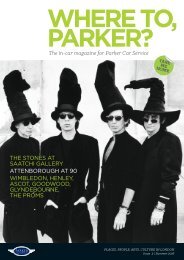Surbiton_Trophy_Programme_2017
You also want an ePaper? Increase the reach of your titles
YUMPU automatically turns print PDFs into web optimized ePapers that Google loves.
“I lived three miles away<br />
from our courts and I used to<br />
walk or run there every day.<br />
That kept me fit.”<br />
1949 & 1950 British champion Joan<br />
Hughesman<br />
Marat Safin<br />
In the era before commercial jets, travelling to<br />
tournaments took even longer. In the 1940s, for<br />
example, if a British player wanted to compete in<br />
the Australian Open, that required a five-week boat<br />
trip.<br />
“In 1948 I was a member of the first team to<br />
fly the Atlantic to play in the States,” Mottram<br />
remembers. “We left Heathrow on a Stratocruiser.<br />
It was two hours to Gander in Ireland; 11 to Halifax<br />
in Newfoundland; and another six and a half hours<br />
to New York.”<br />
Hughesman remembers how, in her day, the<br />
Australian Champion didn’t come over to Europe<br />
“because she couldn’t afford the boat fare”.<br />
Media commitments<br />
Compulsory press conferences, photo shoots,<br />
magazine interviews, TV appearances, radio<br />
broadcasts, websites, social media… modern<br />
players can’t pick their noses without it<br />
being reported worldwide.<br />
Back in the amateur days, though,<br />
all that was required was a quick chat<br />
with a couple of newspaper reporters.<br />
“Everyone would use the clubhouse<br />
facilities so the media would just<br />
go up to players and ask questions,”<br />
Hughesman explains. “There were no<br />
organised press conferences.”<br />
To help pay his travel expenses, Tony Mottram<br />
even became a tennis correspondent himself.<br />
“After matches I was up ‘til midnight most nights<br />
typing away on a portable typewriter. But you<br />
weren’t allowed to write about a tournament<br />
when you were still in it.”<br />
Equipment<br />
Modern pros regularly walk onto court with six<br />
or eight rackets in their bag, in case of multiple<br />
string breaks. And you can guarantee they’re being<br />
paid handsomely to use them. Russian player<br />
Marat Safin had such a good relationship with<br />
his racket sponsor that they didn’t mind the fact<br />
that he smashed almost 100 of them every year in<br />
anger.<br />
Compare this to the situation in the 1940s.<br />
“Rackets were like gold dust after the War.”<br />
Mottram remembers. “I originally had a deal<br />
with Dunlop where they charged me £10 a season<br />
for rackets and restrings. But once I’d played at<br />
Wimbledon I got them free.”<br />
Clothing<br />
The world’s top tennis clothing manufacturers pay<br />
millions for players to be their clothes horses. Not<br />
surprising when you think how many hours they<br />
appear on TV sporting logos from head to toe.<br />
No such sponsorship back in the 1940s<br />
when players were very much left to their<br />
own devices. After the War, Mottram<br />
persuaded a friend who was flying<br />
freight to India to buy plimsolls from a<br />
market stall there. “They were a bit too<br />
big and really flimsy, but I used them<br />
at Wimbledon because I didn’t have<br />
anything else. The soles were completely<br />
smooth – great on grass when it was dry<br />
but if there was the slightest bit of moisture<br />
you’d slip.”<br />
During matches he wore his old gym vests and<br />
shorts from his days in the RAF. “We looked a<br />
real motley lot.”<br />
Hughesman remembers how sports clothing<br />
was so scarce that, early in her career, she had to<br />
make her own.<br />
In memory of Tony Mottram, the 1947<br />
Wimbledon doubles finalist, who sadly<br />
passed away last year at the age of 96.<br />
www.LTA.org.uk/aegonsurbitontrophy @<strong>Surbiton</strong><strong>Trophy</strong> 23

















